Bonsai Trees
Case Histories
Field Maple - (acer campstre)
Field Maple Bonsai Style: Informal Upright
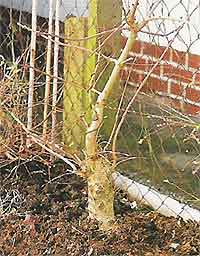
The following two field maples (see other field maple history) were both collected from a hedgerow that was being removed to make way for a new road. Being early summer the trees were in full leaf and with the help of a JCB complete with friendly operator, the largest tree was lifted with the root ball remaining almost intact. I was sure that this tree would hardly even notice that it had been moved. Growing to one side was a small seedling that I also saved.
Both trees were planted in the ground straight away, to help the trunks attain more girth, as they lacked taper. These histories illustrate two different approaches of growing on in the garden to achieve thicker, well proportioned trunks.
Field Maple Bonsai History: Training
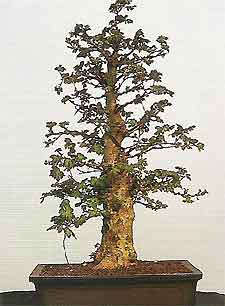
This tree was by far the larger of the two, being around 2 1/2 metres (8 feet) tall. The base was excellent and the tree had obviously been trimmed back for many years. The upper part of the trunk was poor, being very straight and thick. With a good buttress, a front was easy to select and so I reduced the tree in height to about 26 cm (10 inches), using a suitable side branch to train up as a new leader. Anxious not to disturb the roots as the tree was in leaf, a big hole was dug and the field maple planted in the ground to grow on.
Being a sunny day the tree had started wilting. I watered in well and in a matter of hours the leaves had perked up and by the next week the shoots had begun to extend. The tree was allowed to grow with no pruning so that it could recover and the new leader could start to thicken. I rubbed off many persistent buds which kept forming at the base and mulched with well rotted horse manure.
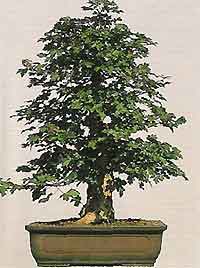
The next year the new leader grew considerably. A small shoot was utilised as a replacement apex, with the existing top of the tree becoming a back branch, left only to thicken the trunk below.
The rest of tree was kept trimmed whilst this 'sacrifice' branch grew strongly and thickened. When it was removed two years later in the summer, the pruning scar was hidden at the back of the tree and therefore not visible from the front. Good taper had been created in the leader, which was now beginning to increase in girth.
Summer is a excellent time for the removal of major branches, as the sap flow slows down and the resultant callouses will be smaller and more even. Over the next three years, the same process was repeated. More sacrifice branches were allowed to grow, which were removed annually. The main shoots grew vigorously each year and were then pruned back hard.
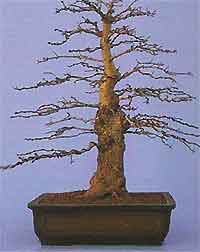
After a total of five years in the ground, the upper portion of the tree merged well with the original stump and a solid shaped trunk, with excellent taper, had been created. The tree was taken out of the ground in late spring and all branches were removed completely, leaving just the trunk. I reduced the height and planted in a large rectangular bonsai pot.
Maples are usually very tolerant of hard root pruning, especially when many branches have been removed. All thick roots were cut back to fibrous roots where possible and buds soon erupted from all over the trunk.
I selected those best positioned to create the formal branch structure that I had in mind. Later in the year, many of the shoots were cut back and wired downwards.
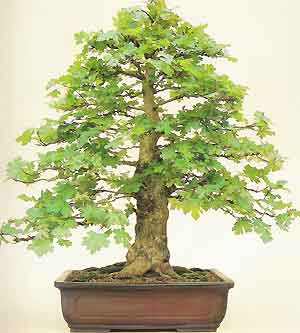
The following year I repotted the maple and allowed it to grow virtually unchecked, helping to thicken the lower branches. Occasional trimming at the top of the tree was necessary, as branches higher up should remain thinner, not becoming heavy and clumsy. New shoots were regularly wired into position and I knew that it would not be long until this tree became a good specimen.
Last winter the tree was radically structured and thinned out, with several large branches being removed. This opened out the tree when in leaf and prevented it looking like a mass of leaves. Extensive wiring was carried out and I decided to make a real feature of the lower branches, which I kept fairly long and spreading.
This method of growing on and cutting back has been enhanced by the use of sacrifice branches, which were selected to grow at the back of the tree to make the scars unnoticeable from the front. A substantial trunk has been created in a relatively short space of time. In several years, being a maple, these wounds will callous over well and it will be difficult to see exactly where they were.
 The following two field maples (see other field maple history) were both collected from a hedgerow that was being removed to make way for a new road. Being early summer the trees were in full leaf and with the help of a JCB complete with friendly operator, the largest tree was lifted with the root ball remaining almost intact. I was sure that this tree would hardly even notice that it had been moved. Growing to one side was a small seedling that I also saved.
The following two field maples (see other field maple history) were both collected from a hedgerow that was being removed to make way for a new road. Being early summer the trees were in full leaf and with the help of a JCB complete with friendly operator, the largest tree was lifted with the root ball remaining almost intact. I was sure that this tree would hardly even notice that it had been moved. Growing to one side was a small seedling that I also saved. This tree was by far the larger of the two, being around 2 1/2 metres (8 feet) tall. The base was excellent and the tree had obviously been trimmed back for many years. The upper part of the trunk was poor, being very straight and thick. With a good buttress, a front was easy to select and so I reduced the tree in height to about 26 cm (10 inches), using a suitable side branch to train up as a new leader. Anxious not to disturb the roots as the tree was in leaf, a big hole was dug and the field maple planted in the ground to grow on.
This tree was by far the larger of the two, being around 2 1/2 metres (8 feet) tall. The base was excellent and the tree had obviously been trimmed back for many years. The upper part of the trunk was poor, being very straight and thick. With a good buttress, a front was easy to select and so I reduced the tree in height to about 26 cm (10 inches), using a suitable side branch to train up as a new leader. Anxious not to disturb the roots as the tree was in leaf, a big hole was dug and the field maple planted in the ground to grow on. The next year the new leader grew considerably. A small shoot was utilised as a replacement apex, with the existing top of the tree becoming a back branch, left only to thicken the trunk below.
The next year the new leader grew considerably. A small shoot was utilised as a replacement apex, with the existing top of the tree becoming a back branch, left only to thicken the trunk below. After a total of five years in the ground, the upper portion of the tree merged well with the original stump and a solid shaped trunk, with excellent taper, had been created. The tree was taken out of the ground in late spring and all branches were removed completely, leaving just the trunk. I reduced the height and planted in a large rectangular bonsai pot.
After a total of five years in the ground, the upper portion of the tree merged well with the original stump and a solid shaped trunk, with excellent taper, had been created. The tree was taken out of the ground in late spring and all branches were removed completely, leaving just the trunk. I reduced the height and planted in a large rectangular bonsai pot. The following year I repotted the maple and allowed it to grow virtually unchecked, helping to thicken the lower branches. Occasional trimming at the top of the tree was necessary, as branches higher up should remain thinner, not becoming heavy and clumsy. New shoots were regularly wired into position and I knew that it would not be long until this tree became a good specimen.
The following year I repotted the maple and allowed it to grow virtually unchecked, helping to thicken the lower branches. Occasional trimming at the top of the tree was necessary, as branches higher up should remain thinner, not becoming heavy and clumsy. New shoots were regularly wired into position and I knew that it would not be long until this tree became a good specimen.